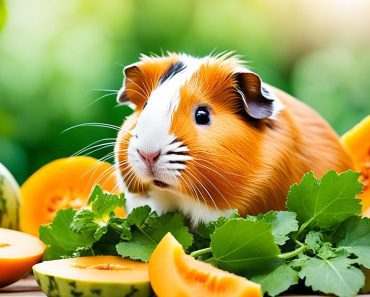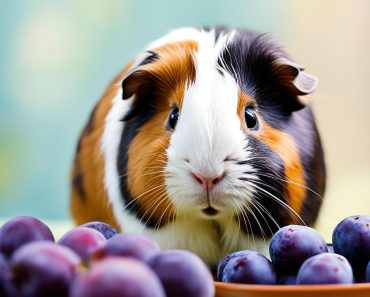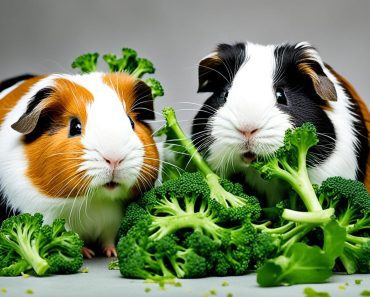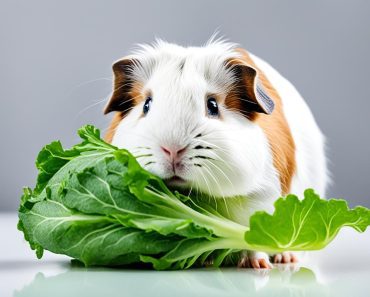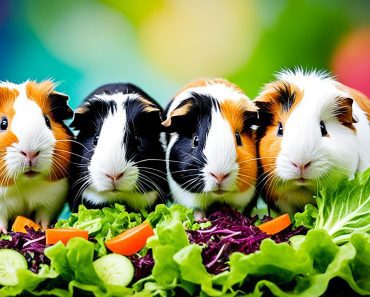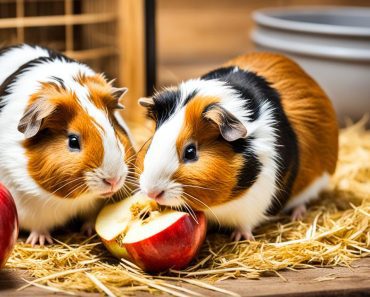Giving our furry friends the right kind of food is essential for their overall health and well-being. As a guinea pig owner myself, I understand the importance of providing a balanced and nutritious diet. One question that often comes up is whether guinea pigs can eat pumpkin. Let’s find out!
Pumpkin is safe for guinea pigs to eat, but it should be given in moderation. While pumpkin offers some health benefits, excessive consumption can lead to certain health issues. It’s important to understand the dos and don’ts when it comes to feeding pumpkin to your guinea pig.
Can Guinea Pigs Eat Pumpkin? Yes, they can. As a once in a while snack.
- Pumpkin can be fed to guinea pigs as a treat, but it should only be given in moderation due to potential health issues.
- Pumpkin contains vitamins A and C, as well as potassium, which can benefit your guinea pig’s eye health, immune system, and digestion.
- Avoid feeding guinea pigs pumpkin seeds as they can cause choking and have a high fat content.
- Monitor your guinea pig’s excrement to adjust the amount of pumpkin given and prevent digestive problems.
- Provide a balanced diet that includes commercial guinea pig food, Timothy hay, and a variety of fresh vegetables and fruits.
Nutritional Benefits of Pumpkin for Guinea Pigs
Pumpkin provides several nutritional benefits for guinea pigs. It contains vitamins A and C, which are essential for eye health, skin hydration, immune system function, and healing. Pumpkin is also rich in potassium, which helps regulate fluids, muscle contractions, and nerve signals. Additionally, pumpkin is high in fiber, which aids in digestion and helps maintain healthy blood sugar levels. The fiber content in pumpkin is beneficial for guinea pigs’ digestion and contributes to their overall health.
Incorporating pumpkin into a guinea pig’s diet can offer these nutritional advantages:
- Vitamins: Pumpkin is an excellent source of vitamins A and C, which are essential for optimal health. Vitamin A promotes good eyesight, while vitamin C boosts the immune system, aids in collagen production, and supports wound healing.
- Potassium: Guinea pigs need potassium in their diet to maintain proper fluid balance, muscle contractions, and nerve function. Pumpkin provides a natural source of potassium, supporting these vital bodily functions.
- Fiber: Pumpkin is rich in dietary fiber, which is crucial for guinea pigs’ digestive health. Fiber aids in regulating bowel movements, preventing constipation, and maintaining healthy blood sugar levels. It can also help prevent hairballs, a common issue among guinea pigs.
By incorporating pumpkin into their diet, guinea pigs can experience enhanced digestion, improved eye health, bolstered immune systems, and overall well-being.
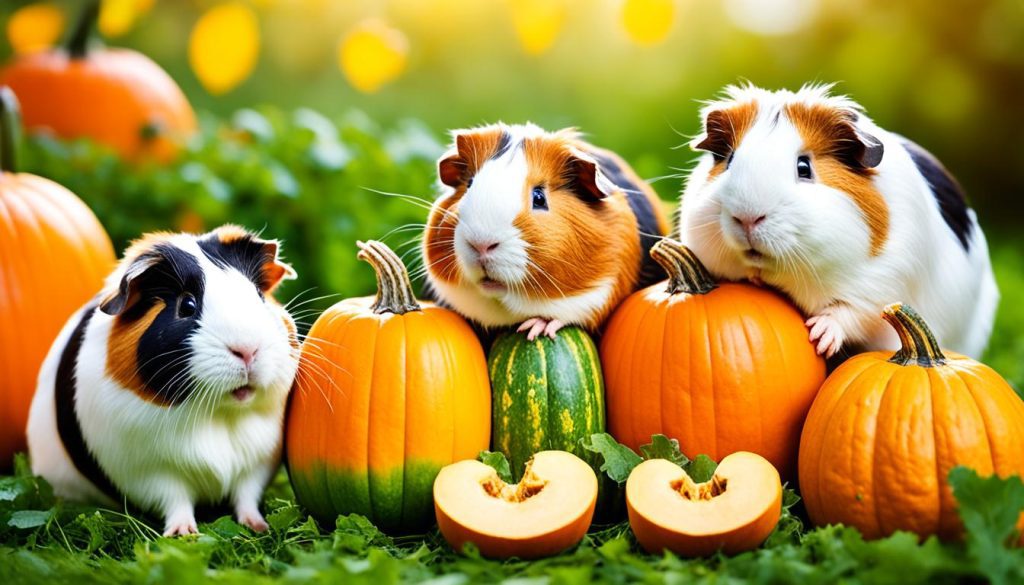
The Table below illustrates the nutritional content found in 100g of pumpkin:
| Nutrient | Amount |
|---|---|
| Calories | 26 kcal |
| Carbohydrates | 6.5 g |
| Fiber | 0.5 g |
| Potassium | 230 mg |
| Vitamin A | 369 mcg |
| Vitamin C | 9.2 mg |
As seen in the table, pumpkin is a low-calorie food that provides essential nutrients for guinea pigs’ overall well-being. The high potassium, fiber, vitamin A, and vitamin C content makes pumpkin a valuable addition to their diet.
Safety Concerns When Feeding Pumpkin to Guinea Pigs
While pumpkin is generally safe for guinea pigs, it is important to be aware of certain safety concerns in order to ensure their well-being. Here are some key considerations:
- Avoid Pumpkin Seeds: Pumpkin seeds should be avoided when feeding guinea pigs. They can pose a choking hazard and have a high fat content that may not be suitable for their delicate digestive system.
- Regulate Water Intake: Pumpkin has a high water content, which can lead to diarrhea if overconsumed. Guinea pigs should have access to sufficient water, but excessive consumption of water-rich foods like pumpkin should be avoided to prevent digestive issues.
- Monitor Sugar Content: Pumpkin contains natural sugars, which can cause constipation and obesity if consumed in excess. It is important to regulate the amount of pumpkin given to guinea pigs and opt for smaller portions to maintain their overall health.
By keeping these safety concerns in mind, you can ensure that pumpkin remains a healthy and enjoyable treat for your guinea pigs. It is crucial to offer a balanced diet that incorporates other nutritious foods alongside pumpkin, such as hay and guinea pig pellets, to meet their specific dietary requirements.
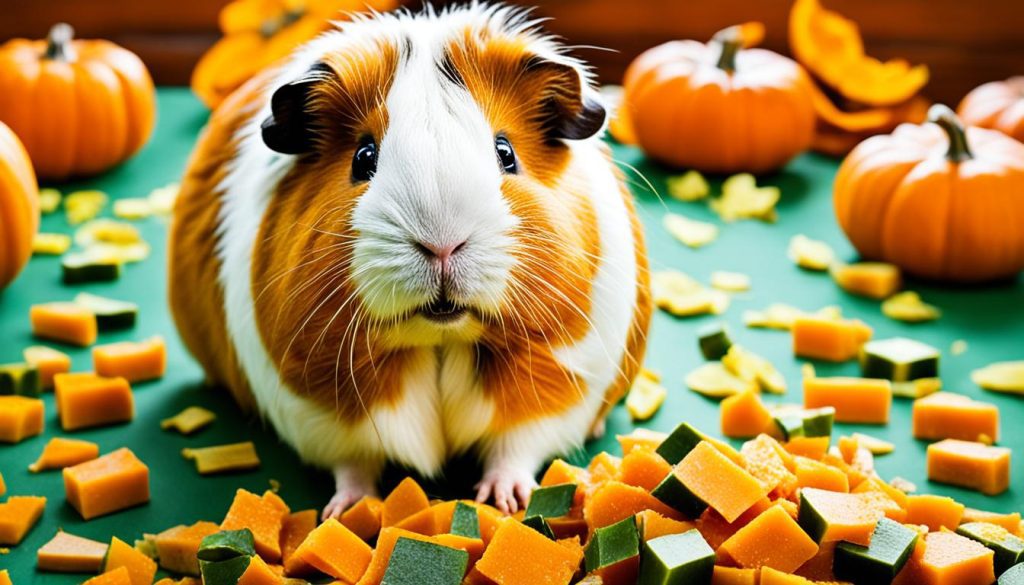
Remember that moderation is key when it comes to feeding pumpkin to guinea pigs. Maintaining a balanced diet and monitoring their overall health will help ensure their well-being and prevent any potential risks associated with pumpkin consumption.
Guinea Pigs’ Preference for Pumpkin
Guinea pigs, like humans, have a sweet tooth and enjoy the taste of pumpkin. They are likely to find it appealing as a treat due to its natural sweetness.
Guinea pigs’ taste for pumpkin can be attributed to their love for sweet flavors. The natural sweetness of pumpkin makes it an irresistible treat for these adorable rodents. Whether it’s the soft flesh or the slightly earthy flavor, guinea pigs seem to have a fondness for pumpkins.
“My guinea pig, Daisy, absolutely loves pumpkin! Whenever I give her a small piece, she devours it within seconds. It’s her favorite treat, and it’s adorable to see her munching on it with joy.”
It’s important to note that while guinea pigs may enjoy the taste of pumpkin, it should still be given in moderation. Too much pumpkin can lead to various health issues, such as digestive problems and obesity. Always ensure that pumpkin is introduced gradually into their diet and served in appropriate portions.
- Pumpkin as a treat:
Due to its high sugar content, pumpkin should only be offered to guinea pigs occasionally as a special treat. This ensures that they receive a balanced diet and don’t consume excessive amounts of sugar.
Overall, guinea pigs’ preference for pumpkin can be seen as a delightful indulgence. However, it’s crucial to prioritize their health and well-being by following proper feeding guidelines.
Proper Feeding Guidelines for Pumpkin
When serving pumpkin to guinea pigs, it’s important to follow proper feeding guidelines to ensure their health and well-being. Here are some tips to help you provide the right portions of pumpkin for your furry friends.
Cleaning and Preparation
Before serving pumpkin to your guinea pigs, make sure to clean the outside thoroughly to remove any dirt or pesticides. Once cleaned, you can serve both the rind and flesh of the pumpkin to your guinea pigs.
Starting with Small Portions
It’s recommended to start with small pieces of pumpkin, about half an inch in size, to introduce it to your guinea pigs’ diet. By starting small, you can observe their response and ensure they tolerate pumpkin well.
Monitoring Excrement
As you gradually increase the amount of pumpkin in your guinea pigs’ diet, it’s important to monitor their excrement to adjust the portion accordingly. If you notice any digestive issues or unusual changes, reduce the amount of pumpkin given.
Serving Frequency
While pumpkin can be enjoyed by guinea pigs, it should be fed in moderation. It’s recommended to serve pumpkin as a treat once or twice a week. This ensures that your guinea pigs receive a varied diet and don’t consume excessive amounts of pumpkin.
When feeding pumpkin to guinea pigs, serve it in appropriate portions, starting small and gradually increasing the amount. Monitor their excrement and adjust the serving size accordingly. Remember that pumpkin should be given as a treat and not as a main staple in their diet. By following these guidelines, you can safely incorporate pumpkin into your guinea pigs’ diet and provide them with a delicious and nutritious treat.
Other Foods for Guinea Pigs
In addition to pumpkin, guinea pigs can enjoy a variety of vegetables and fruits as part of a balanced diet. Incorporating these foods into their daily meals provides essential nutrients and keeps them healthy and happy.
Vegetables for Guinea Pigs
Offering a selection of fresh vegetables is a great way to provide additional vitamins and minerals to your guinea pig’s diet. Some suitable options include:
- Carrots
- Bell peppers
- Kale
- Cucumber
- Spinach
These vegetables are rich in fiber, antioxidants, and beneficial nutrients that support guinea pigs’ overall well-being. Remember to wash the vegetables thoroughly and cut them into small, bite-sized pieces to prevent choking hazards.
Fruits for Guinea Pigs
Fruits make delicious and nutritious treats for guinea pigs. They contain natural sugars, so it’s important to feed them in moderation. Some suitable fruits for guinea pigs include:
- Apples
- Strawberries
- Blueberries
- Bananas
- Watermelon
These fruits provide a tasty source of vitamin C, which is essential for guinea pigs’ overall health. Remember to remove any seeds or pits, and cut the fruits into small, manageable pieces. Offering a variety of fruits ensures a diverse range of nutrients in their diet.
Proper Portion Control
While vegetables and fruits are beneficial for guinea pigs, it’s important to remember that they should only comprise about 10% of their overall diet. The majority of their diet should consist of high-quality guinea pig pellets and fresh Timothy hay. This ensures they receive the necessary fiber, vitamins, and minerals to thrive.
Here is a table outlining the recommended portion sizes for guinea pigs:
| Food | Portion Size |
|---|---|
| Guinea Pig Pellets | 1/8 to 1/4 cup per day |
| Timothy Hay | Unlimited access |
| Vegetables | 1/4 to 1/2 cup per day |
| Fruits | 1 to 2 tablespoons 2-3 times per week |
Remember to introduce new foods gradually and observe your guinea pig’s response. If any signs of digestive upset occur, consult a veterinarian for guidance.
Conclusion
Guinea pigs can enjoy pumpkin as a special treat, but it should be given in moderation. Pumpkin offers several nutritional benefits, including vitamins A and C, potassium, and fiber, which contribute to a guinea pig’s overall health. However, there are safety concerns to consider, such as avoiding pumpkin seeds and regulating the amount of pumpkin given due to its high water and sugar content.
Guinea pigs have a natural affinity for the taste of pumpkin and can enjoy it with both the rind and flesh. It is vital to adhere to proper feeding guidelines, such as starting with small portions and monitoring their response. Pumpkin can be a delightful addition to their diet when served appropriately.
As responsible pet owners, it is crucial to provide a well-balanced diet that includes other vegetables and fruits, along with commercial guinea pig food and Timothy hay as staples. By following these guidelines and treating pumpkin as an occasional indulgence, you can enrich your guinea pig’s diet and make mealtime a festive experience.

